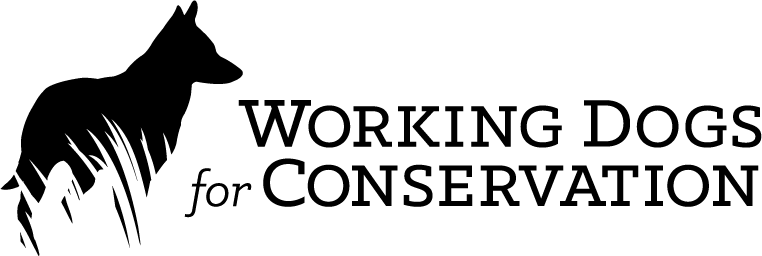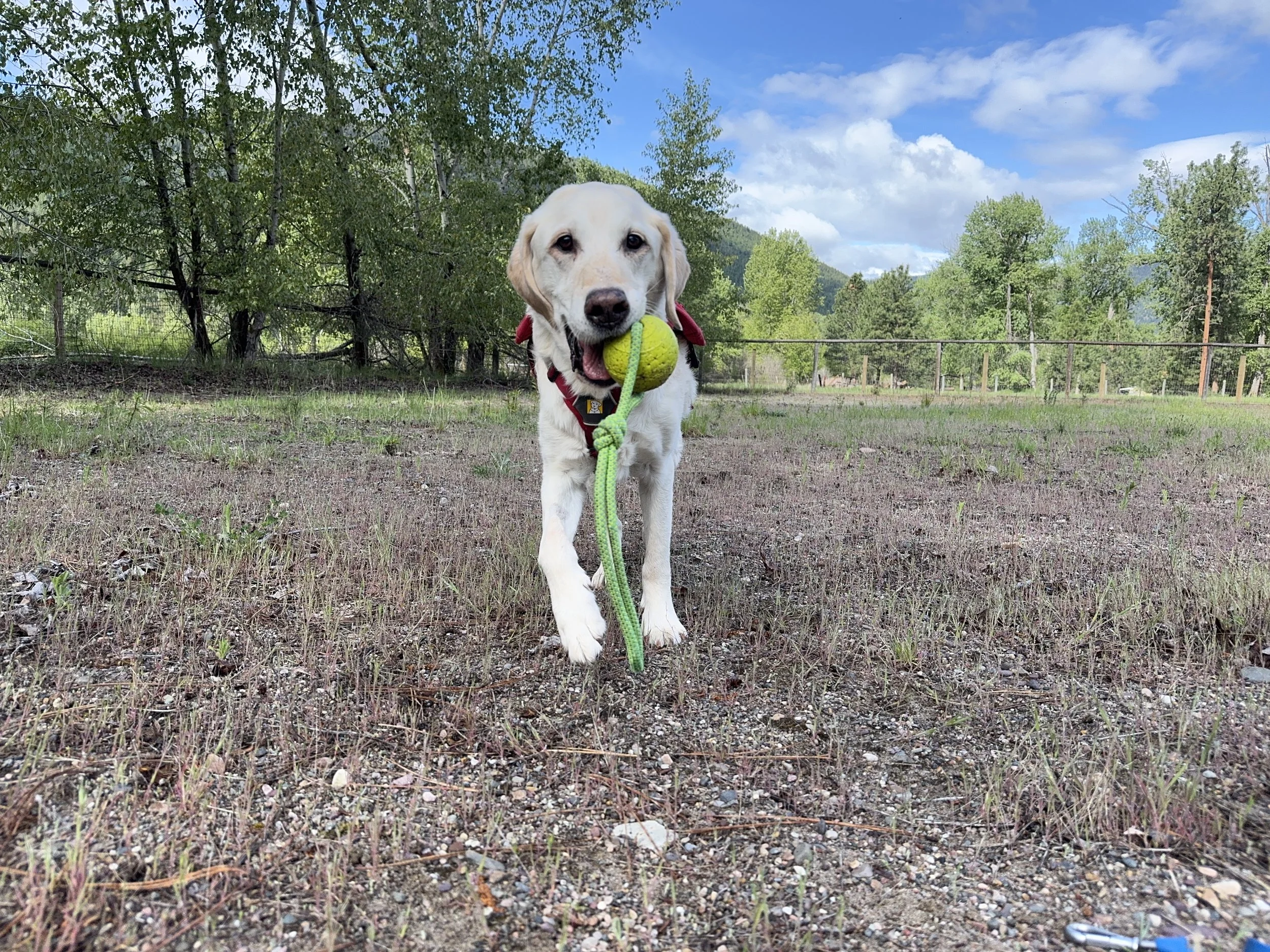Working Dogs for Conservation proudly sources rescue, rehomed, and career-change dogs for our conservation team. We are not breed-specific, and instead look for certain qualities and traits that best fit active project needs. Here is some basic criteria for those seeking placement for a dog, to see if you have a candidate that could potentially be a good fit as a conservation canine.
RESOURCES FOR RESCUES & INITIAL SCREENING CRITERIA
Adding to our pack is a serious and long-term commitment. We on-board new dogs on a staggered timeline, to ensure we have the capacity and resources needed to dedicate to each new recruit. Even after initial on-boarding starts, there are times when a dog may ultimately be determined not to be a suitable fit as a conservation canine, but we are still committed to finding a great placement for that individual dog based on their needs and well-being.
Know that while all dogs are great dogs, not all dogs fit our needs or would do best in our program or a specific project we may be searching for. If you have a dog you’re looking to place, please thoroughly review the content below. If they do not meet this initial broad screening criteria, we have provided additional resources listed as well. Thank you for your interest and support for rescue dogs!
OUR CURRENT PACK STATUS: OPEN (actively searching and ready to add dogs)
Successful Conservation Dog Broad Screening Criteria - First Steps
Please review this section thoroughly and completely before reaching out. Potential candidates don’t need to pass every single requirement, but multiple fails or extreme cases will rule them out. Furthermore, the specific needs of our current and future project(s) will determine what we’re looking for at any one time. There is quite a bit of variation on what behaviors/characteristics are a good fit for each program.
-
Candidates don’t need to pass all requirements, but multiple fails or extreme cases will rule them out
-
Age
1-3 years (exceptions can be made)
Weight
30-65 pounds (this is primarily for travel and transport purposes)
-
Unfortunately, due to the nature of our work and dogs already in our care, we cannot accept a dog with any of the following:
Bite history
Any aggressive bite directed at a human that resulted in broken skin, bruising, swelling, etc. Accidental play bites happen with high-drive dogs, and nips or bites as a result from toy play are not disqualifiers.
Reactivity
Aggressive reactivity to people or dogs like growling, snarling, aggressive barking, aggressive lunging, etc.
Separation anxiety
Separation anxiety that results in emotional distress to the dog or self inflicted bodily harm/injury.
Brachycephalic
Due to the strenuous nature of this work, for safety reasons we cannot accept brachycephalic dogs.
Resource Guarding
Aggressive resource guarding tendencies towards humans and/or dogs. This applies to both food and toys.
Desire to chase or harm wildlife
Excessive desire to chase animals (large or small), or pose any threatening behavior toward wildlife or small prey-like animals.
-
Neutral or Friendly to New People
Our work is often public-facing, including things like school demonstrations, boat checks, etc., while also requiring dogs to travel in public places, such as hotels, airports, public buildings. Therefore, we require dogs to be friendly and/or neutral when meeting new people.
Neutral or Friendly to Dogs
We understand that a big play group isn’t for every dog, but we do need our dogs to be friendly and/or neutral around other dogs. This includes being able to ride in a transport crate next to another dog, being able to walk on leash past another dog, and your dog choosing the play with a toy over other distractions.
-
Low Interest in Wildlife
We work outside around a variety of wildlife, both big and small, and it is essential that our dogs can focus on their work and not be distracted. Also, because we often work around threatened and endangered species, it is essential that our dogs do not chase animals.
Ability to Crate/ Travel in Vehicles
Both at home and on the road, it is important that these dogs are comfortable being crated. This includes rotating between crate time and free time, training or working time, as well as riding in a transport crate in a vehicle. Dogs should be neutral in crates for at least a short period of time, we will work on lengthening their crate stays if necessary through our program.
Good Nerve Strength
Ability and willingness to traverse difficult terrain, stay in hotels, walk through public areas, travel in different types of transportation, such as a car, boat, plane, etc., and be near traffic (on leash). Mild reactivity to novel environmental sounds, but with quick recovery and refocus on the task is okay.
Body Handling Tolerance
Comfortable having body touched, including near eyes, ears, paws, etc., being lifted/carried, wearing booties, wearing a muzzle, etc. This can be trained, but there should be no history of adverse reactions.
Part A: Physical & Behavioral Qualities
Part B: Toy Play Testing
-
If possible, perform all of these tests in an area that is novel to the dog. They may be done with the dog on a long leash if necessary, and they do not have to be performed in succession. The dog should be given breaks and water as needed throughout the test. These tests are best performed using two people. We may ask you to share videos of these tests before proceeding to next steps.
-
AKA: 10 Toy Toss. One person holds or restrains the dog while another person tosses the dog’s favorite toy. Wait for the toy to stop moving before releasing the dog.Remain silent until the dog possesses the toy – verbal praise or recall can be used to get the dog back once they have the toy.
Repeat 9 more times.
(We want to see that the dog will keep going even when it is starting to get hot/tired, so ideally this is done in quick succession, but if at any point the dog is showing signs of heat stress, stop the test and immediately cool the dog.)
-
One person holds or restrains the dog while another person tosses the toy into a location that it is difficult to find. If you cannot find a place with this access such as tall grass, a forest, or similar, you can pretend to hide it in multiple places, have a second person toss from farther away, or toss the toy, then move the dog behind an object and pick the toy up, etc. Get creative for your area.
Release the dog without saying anything and remain silent and stationary until the dog has found a toy or searched for 2 minutes. After 2 minutes, you can help the dog look for the toy if needed.
The goal is for the dog to search for the toy for 2+ minutes, not for the dog to independently find the toy.
-
Restrain the dog, then toss a toy. Wait 1 minute, then quietly release the dog, staying silent while the dog searches for the toy.
*If holding the dog, this is best done with the dog in a harness with a leash attached. If only one person is available, you can back tie the dog (in a harness) or place the dog behind a fence or gate.
-
During any of the above tests, after the dog has found the toy, stay silent and ignore the dog while they possess the toy for 1 minute. Do not reach for the toy, talk to the dog, or engage with the dog in any way.
Seem Like a Potential Fit as a Conservation Canine?
Has the dog you’re seeking placement for passed these initial Part A & B screening steps? Great! If we are not at full pack capacity and currently seeking new dogs, we’d like to learn more! Please reach out to us at info@wd4c.org
Other Placement Resources
If we’re at full pack capacity and/or if the dog you’re seeking placement for has not met these initial Part A & B criteria, don’t give up hope! It’s still very possible they have great potential with a program outside of WD4C. We recommend these resources:
National Disaster Search Dog Foundation
There are also numerous Facebook pages dedicated to the placement of dogs like this including: Adoptable Sport and Working Dogs, Adoptable Sport and Performance Dogs, and Adoptable Bro Dogs.





